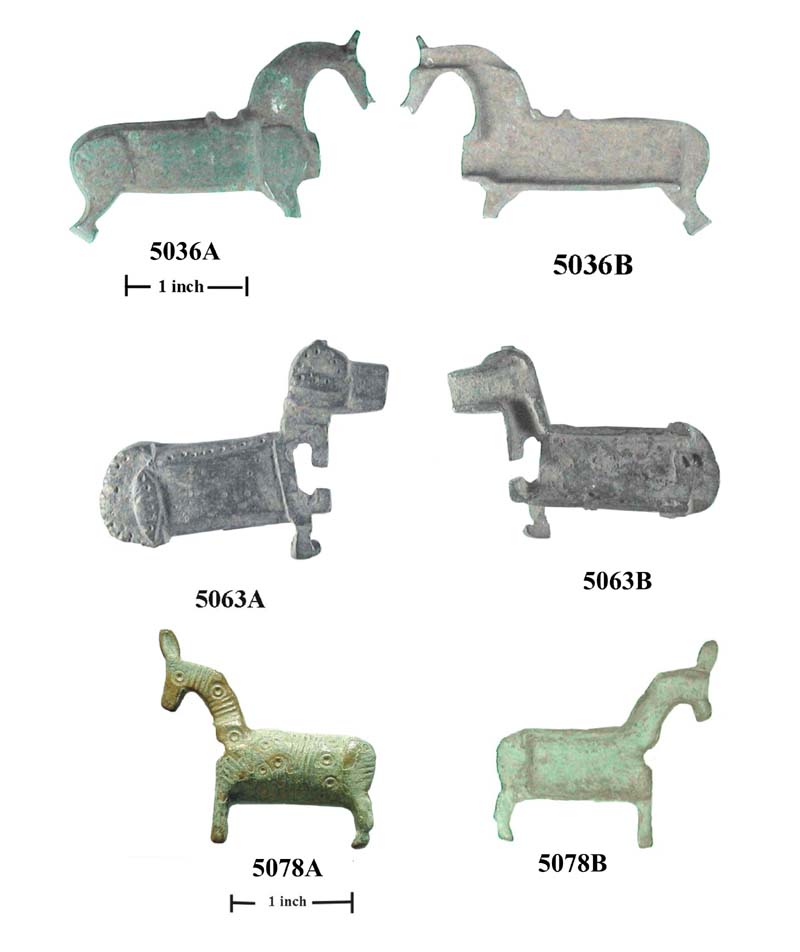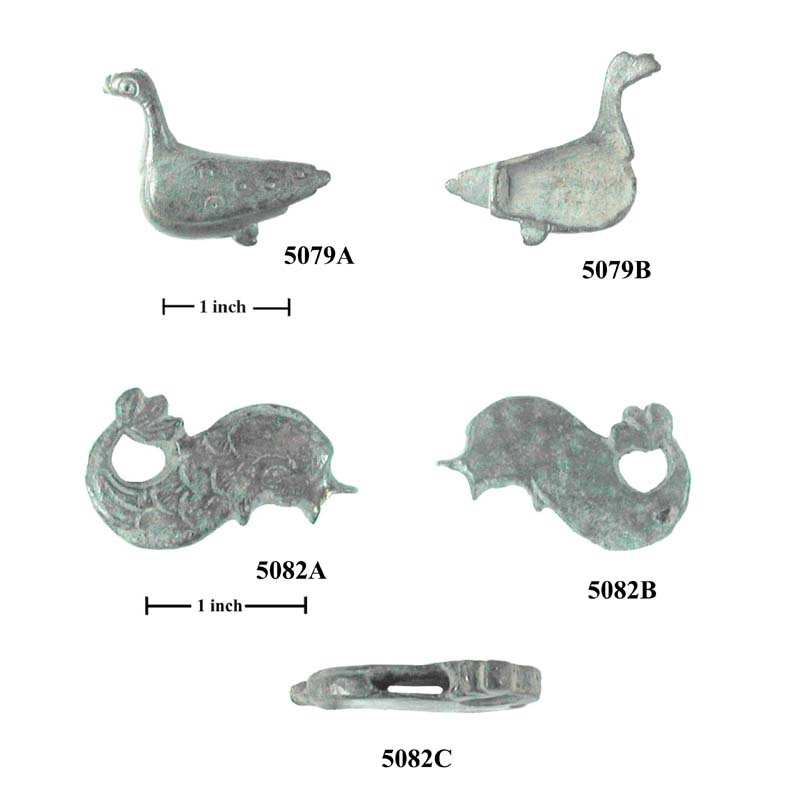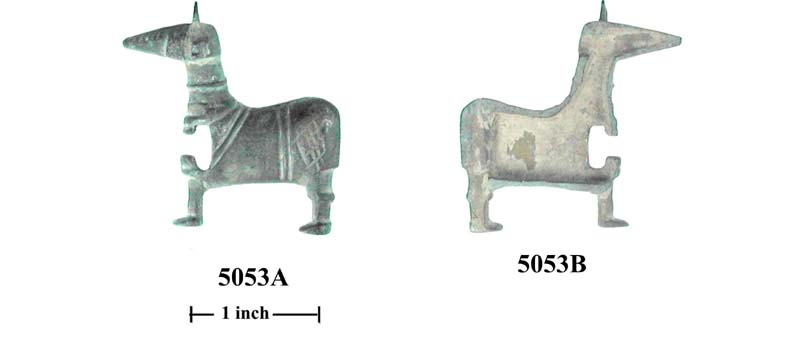
![]()
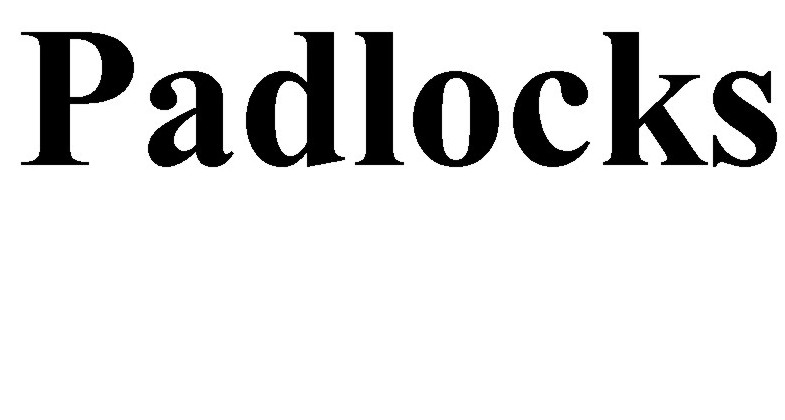
![]()

Surviving Roman padlocks are rare. The basic types are barrel locks, iron barbed spring locks, and figural locks. Barrel locks were made in both iron and bronze, while figural locks are found only in bronze.
Enough Roman iron barbed spring padlocks and keys have survived to give us a
good idea of their design and function. This is especially true since similar
locks 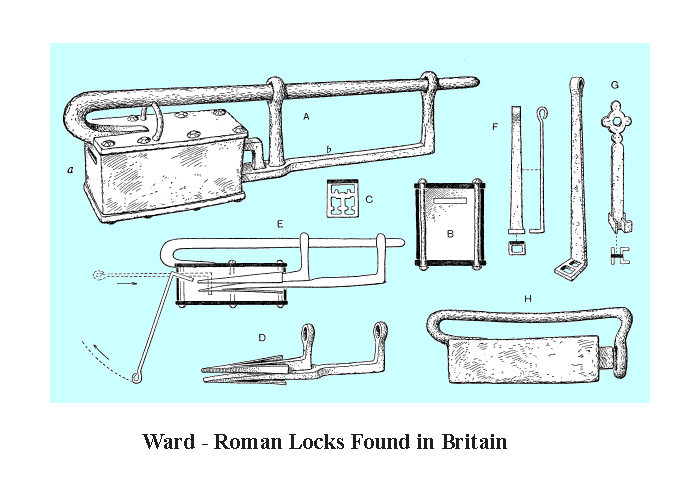 were in use until very recent times. Shown here are some examples found
in Britain (Ward, 1911)
were in use until very recent times. Shown here are some examples found
in Britain (Ward, 1911)
Small bronze barrel padlocks (2" or less) with barbed spring mechanisms that I have seen, sometimes ascribed to Roman times, are medieval.
Three iron barbed spring padlocks (4899,5034,5073) are shown here that
have an unusual configuration that I have not seen described previously. The
keyhole is on the side of the case, requiring a curved slide key. The case is
divided into upper and lower compartments. They are separated except at the
front, where there are two openings. At the end of travel of the key, the bits
on the end of the key pop up from the lower to upper chamber, compressing the
two springs. With a side keyhole, the curve of the  key would be
critical in opening such a lock.
key would be
critical in opening such a lock.
4865 Large iron padlock with attached chain. Also quite similar to 4899, except there is a conventional keyhole at the end for a slide key.
4899 Large iron padlock with attached chain. The spring assembly enters high on the end of the case, which has a hooded extension. Possibly this is to protect the stop on the spring shaft from prying. The rectangular keyhole on the lower side would admit a simple, slightly curved key to reach the compressible end of the spring.
4900 a, b Small iron padlock. This lock shows evidence of joining by brazing. The design is little different from that of some Asian padlocks of the last few hundred years.
5023 b This is a strange one, the only example of this style I've ever seen. I can think of a couple of reasons to not put the keyway on the top of the case. It would allow water and dirt to enter, and it would provide would-be lock pickers with a grand view of the mechanism. The lock itself is in good condition for a dug lock of any age, and could even be restored to working order if anyone cared to make the spring & bolt assembly. Key 361 that is shown with it, although they were not found together, is a near fit and shows the design that would be required. If the neck were just a bit narrower, it could slide down the slot and compress the (missing) springs.
5034 This little iron padlock is a smaller version of 4899. The keyhole is on the side, although it's the opposite side, and is circular rather than rectangular.
5122 Rectangular box lock of sheet iron, bent over a bottom/end piece and reinforced at the bottom with a pair of riveted iron strips. Don't see any evidence of brazing.
Cots-1 An iron box type padlock, found in Britain (admin.cotswold) of riveted construction, similar to that illustrated by Ward, above.
Barbed spring padlocks
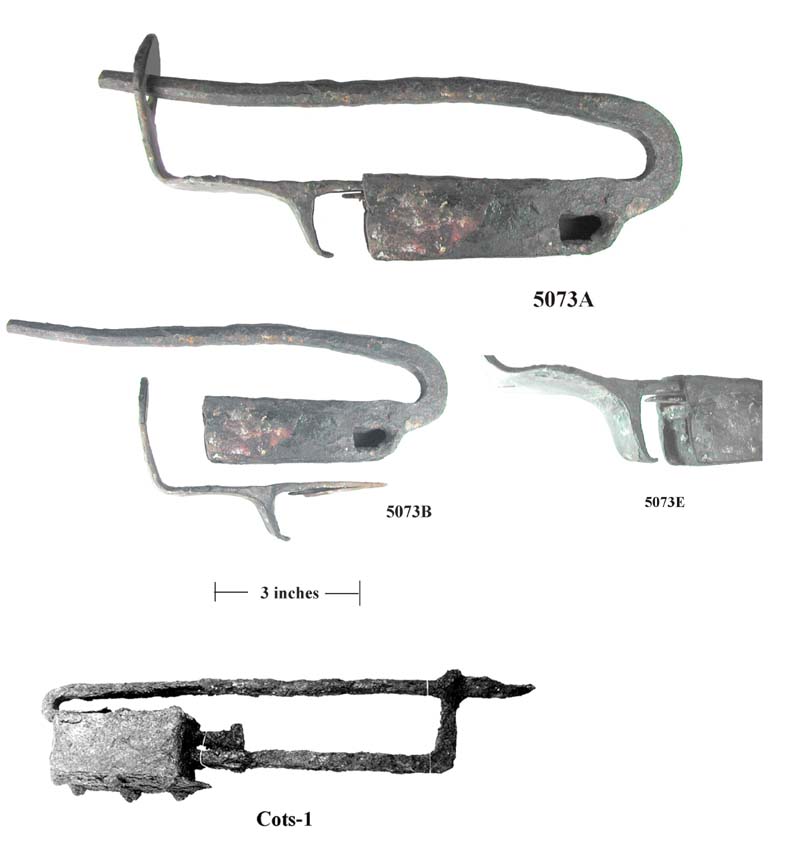
Some mention of restraints (shackles, manacles, fetters, handcuffs) should be made here, although there are none that can be identified as such in this collection. They often incorporate barrel and box padlocks in their designs. Most such are iron barbed spring padlocks, and some are similar to those described above. An excellent source of information on this hardware is Thompson (Iron Age and Roman Slave-Shackles). I'm showing here an example from Thompson (figures 64,65). This can be thought of as simply a rectangular iron box padlock with an unusual shackle attached.

Chains. We have many examples of Roman chains. As shown above, chains for rough usage were often made of elongated iron links, which provides the most length with the least amount of fabrication. For barrel locks, the end link in a padlock chain was elongated for insertion into a small slot. Roman chains have also been found that are very delicate and sophisticated. Chain design has changed little since classical times, although methods of fabrication have improved tremendously. I don't really collect unattached chains, and will show only a single example 5101 with carefully shaped bronze links.
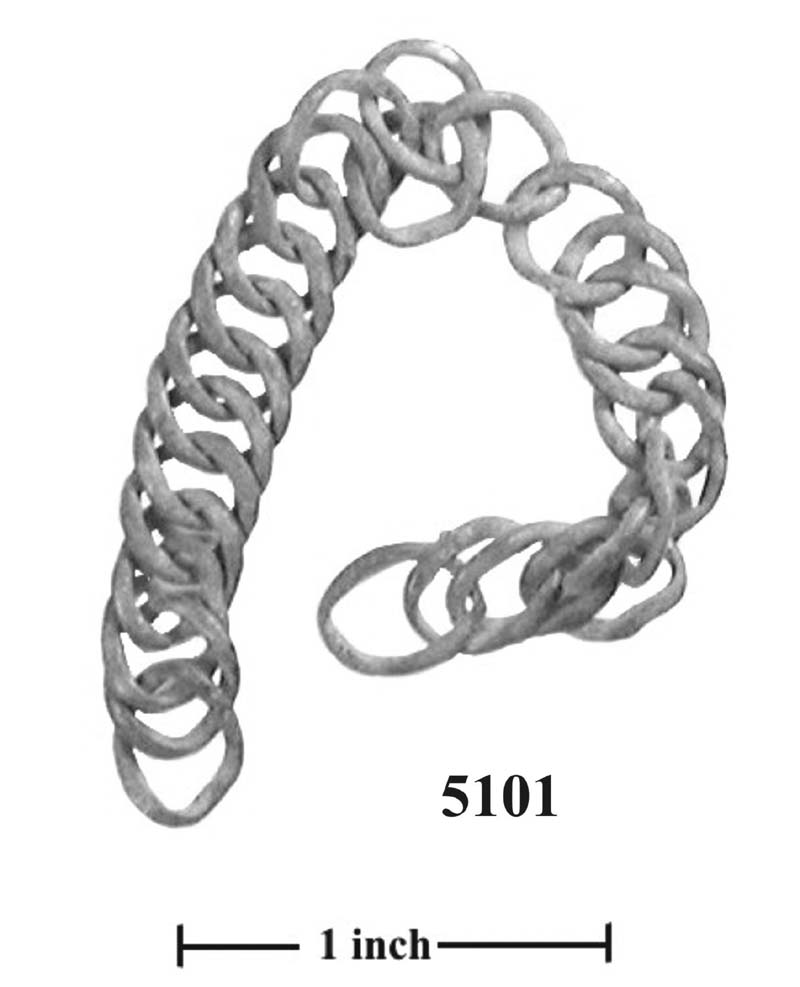
The invention of the barrel padlock. It is very difficult to believe that the Roman barrel padlock sprang full blown from the mind of a single ancient lock maker. Like most inventions, it must have been a further development of something earlier, an "improvement" on existing hardware. I suggest the following as a plausible path by which such a development might have taken place. As remarked in the section on chest lock hasps, it is likely that Roman locksmiths made up prefabricated chest lock assemblies that could be selected by a customer and simply nailed or pinned onto a new chest.
One can imagine a locksmith looking at such an assembly and noting that if the bronze sheathing were extended all the way around the wood core and the fastening of the hasp transferred to a slot in the lock case, a portable lock could be created. In fact, many Roman padlocks had a wood core, and several can be seen in this gallery. Additionally, the five padlocks recovered from the ruins of Pompeii and published by Biasiotti all have wood cores. The "Pompeii" type lock that he illustrates, (shown here) looks very much like a chest lock with the addition of a shackle!
One consequence of such a scenario is that it would have been necessary to dispense with the pin tumbler mechanism, which has a bolt that is too bulky for a small unit. The bolt now only moves a short distance inside the barrel, and the key that moves it no longer needs pins. This is not much of a change, though, since we know of both barrel locks and chest locks with T-shaped keyholes, presumably for warded lift keys, and with keyholes for a rotary mechanism.
An important description of Roman iron barrel locks and keys can be found in Ewald. Sixteen such locks were found and examined at Augst. Photos, x-rays and text are presented. A detailed drawing of the parts of one is given, and a reconstruction made.
Barrel padlocks
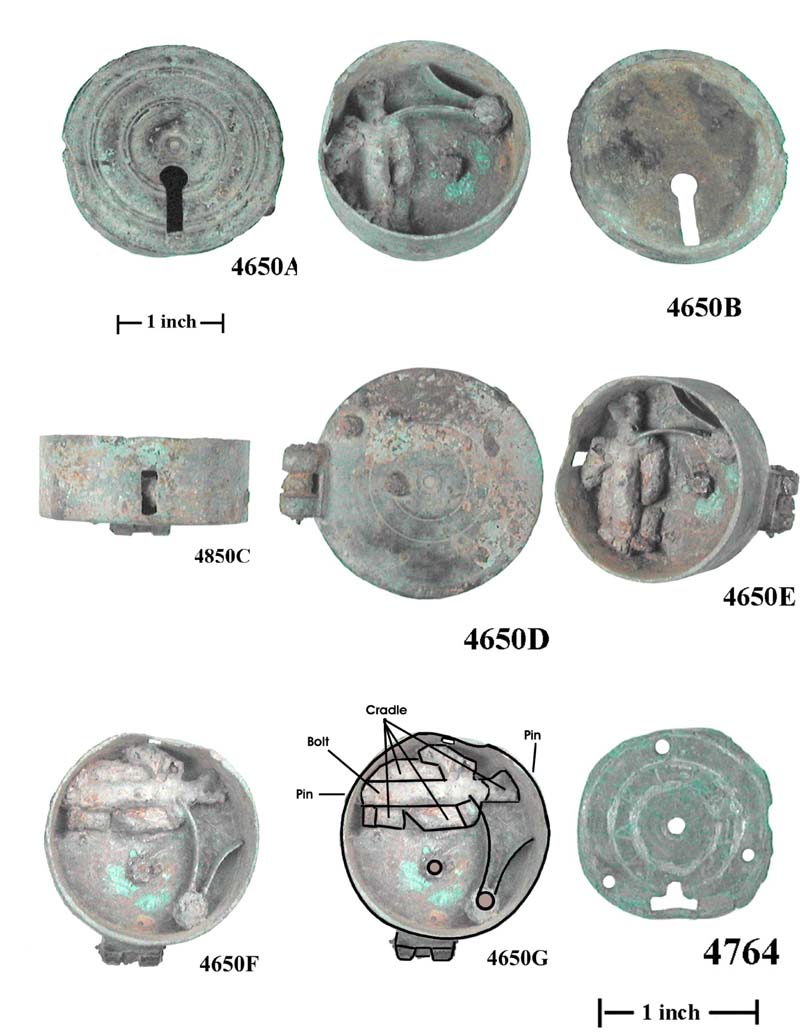
It should be noted that this hypothesis does not necessarily give this type of lock priority of invention over the iron barbed spring padlock, which has a completely different and generally more robust mechanism and case. The more sophisticated figural "face" padlock must have had still another history and is probably much later.
A variant of the fixed shackle barrel padlock is the chain lock. If instead of inserting the end of a hasp into the slot on the top plate of the padlock, the end link of a chain were inserted, a more flexible lock could be created, useful for large or irregularly shaped objects. This would usually mean that the slot would be larger than the small slot required for the end of a fixed shackle.
For few examples of the barrel/chain lock, the mechanisms have been worked out in considerable detail (Manning 1968 and Anstee 2001 There is also Jacobi, 1897, which I have not seen.) They are complex and very carefully made, depending on springs and accurately fitted parts. Study of these mechanisms inspires a great deal of respect for the Roman locksmith.
4650 a-g This is a pill box shape chain lock, important for its apparently complete mechanism. The shapes of the parts are blurred by corrosion, so that I'm not 100% sure of my interpretation, but in figures 4650f and 4650g I've shown how I believe it was constructed and operated. Probably more could be learned if the corrosion were removed, but I'm unwilling to do that. Some observations follow:
1. The fitting on the lower outside edge is a chain swivel
2. The key was a barrel type, with the keyhole centered over the swivel. The key post was iron, now broken off. The spring post is also iron
3. The top plate is a casting, which was joined to the case by soldering.
4. The case, sides and bottom, is a single casting. No joining marks visible. The lid is wider than the case, but there is solder residue on the underside which exactly matches the wall of the case.
5. The entrance hole for the other end of the chain is a slot in the side of the case. The chain was fine, with an end link diameter of not more than 0.25".
6. The locking assembly consists of a bolt mounted in a cradle. The cradle is pinned into the side of the case at each end with iron pins.
7. The cradle and spring prevent the bolt from rotating to release the chain link, so it must slide when the spring is compressed by the key, and rebounds to lock. It's not clear how it was kept in place vertically.
8. The bolt has been damaged in antiquity, bent down by being struck with a something like a chisel.
9. There is a single decorative scored line around the outside of the case at the top of the shackle slot.
10. On the bottom of the case there is a central pit and two concentric circles for decoration,.
11. There is a dent in the side of the case near the top of the shackle entrance slot. This was done in antiquity. There is no corresponding damage to the top plate except for a small gap in the soldering residue.
4764 This is a barrel lock cover plate only, but has the rare distinction of having an inscription. (MARTINUS) Lift key type, traces of silvering. Note that the S is reversed. See also 5089
4854 a,g,i,l Iron barrel/chain lock, remarkable for its size and as an iron survival. Don't know what's left inside, and it should be x-rayed.
4858 a,b Pretty little octagonal bronze barrel lock with iron shackle and rotary key mechanism
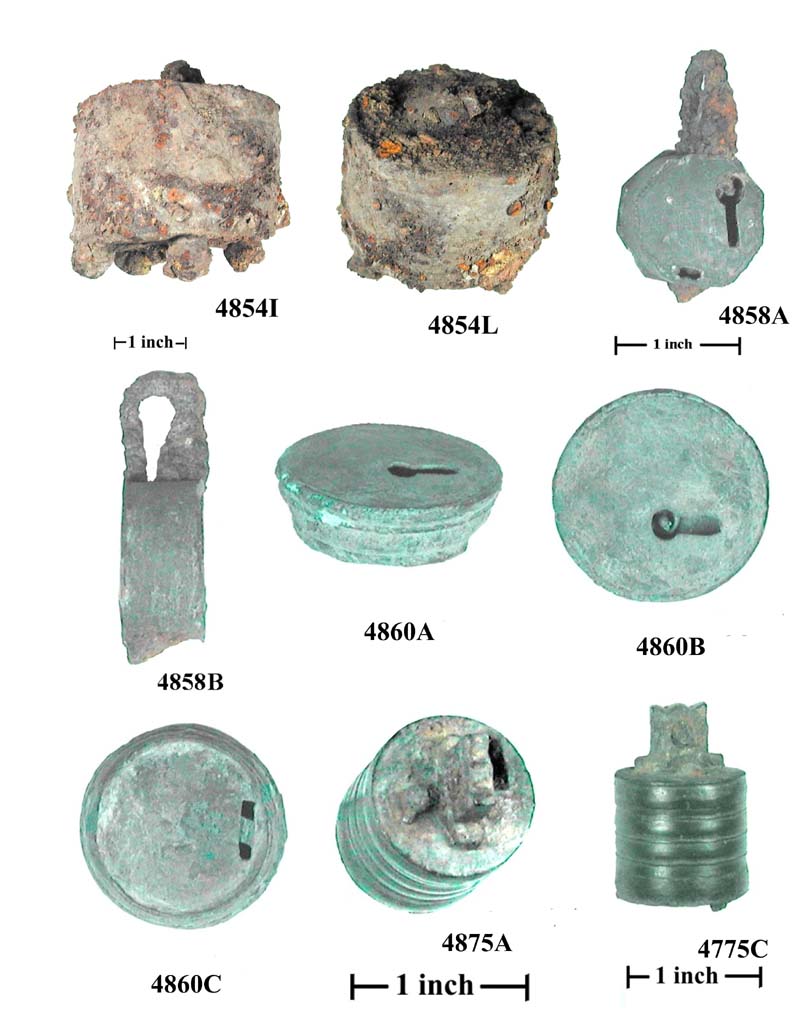
4860 a,b,c Another "pill box" barrel/chain lock. The other end of the chain appears to have been soldered onto the back of the lock, and nothing remains but a roughened surface. The mechanism is bronze, and appears to be intact.
4875 a-h Elegant, sturdy barrel/chain lock, with obvious attachments for the chain. This is heavy, and I believe has a remaining wood core. I've so far refrained from touching the inside debris.
4877 a-f This is an extraordinarily delicate and complex lock, operated by a very tiny lift key. It was clearly a luxury item, meant more for display than actual security. There were originally two locking arms, of which one is missing. The dual shackle arrangement has no obvious purpose, except to be admired for its ingenuity. They fit into a T-shape post. Inside, the bottom hole in this post is also pierced by a locking pin, operated by the handle at the left. There was originally a wood core, of which pieces remain.
5103 Very similar to 4877, with a large amount of wood core remaining. It's in very delicate condition.
DSPBIAS. Another such double-shackle padlock has been illustrated by Biasiotti in his CD on Pompiian locks. It has a different mechanism, barbed spring, but shows that the double arrangement of 4877 is not unique.
4898 a,b,g,h Huge, sturdy bronze barrel/chain lock. The inside is a maze of iron partitions, and I've not yet worked out just how the mechanism worked. The bottom plate is iron, with a chain link embedded in it. The case is of thick cast bronze, and this lock would not have required any wood core for support. I would say it was for actual security use, not a prestige item.
4936 d-l Pretty little barrel lock with a shackle, bronze "feet" on the bottom and an intact wood core
4943 a-h Another quite fragile lock, sheet bronze sides 0.013" thick Intact case, shackle and four original case pins, main lever and external center post. Very likely had a wood core
4990 This was advertised as a chest lock plate, but not so. The width of that rectangular slot is much to wide for a hasp, and is suitable for the end link of a chain. Also, this is a heavy plate, cast not cut from sheet. It is in fact the top plate of a barrel padlock, and as far as I now know, all round lock plates are the lids for barrel locks. The smallest hole, surrounded by a reddish stain, marks the mounting pin for an iron partition.
5089 I've inserted this cover plate just below 4764 because of the similarity. This one still has the center boss. There are again traces of silvering, and the keyhole is a bit larger. Note that this is not repousse; there are no traces of the circular decorations on the underside.
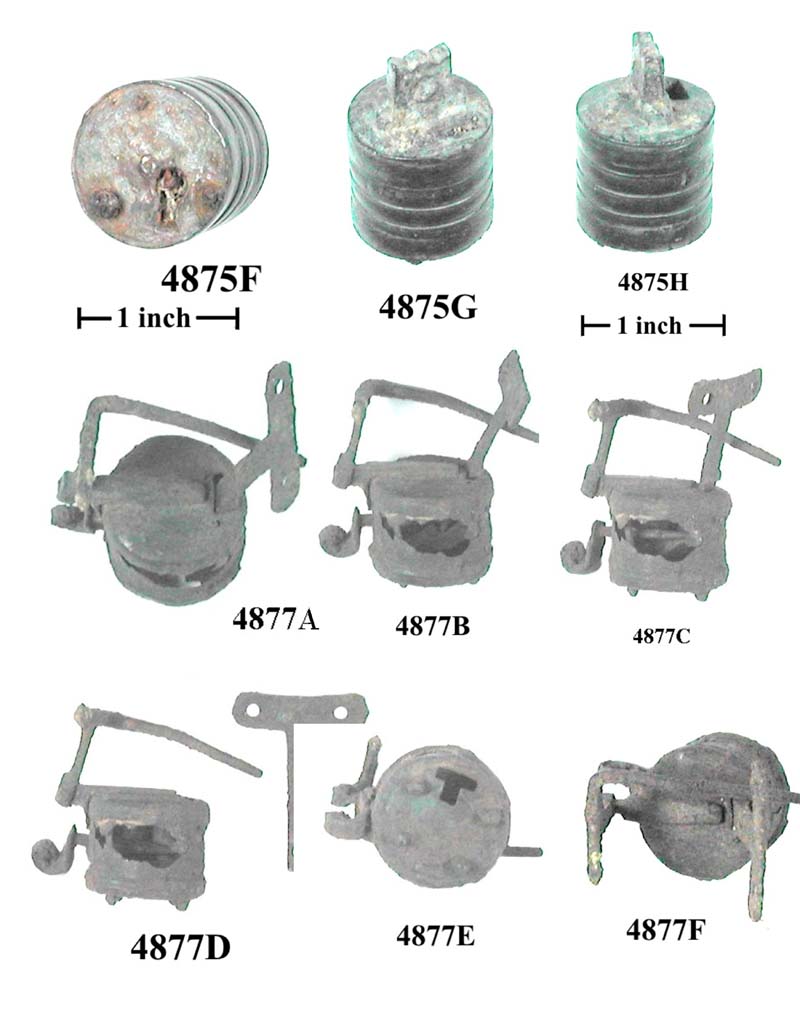
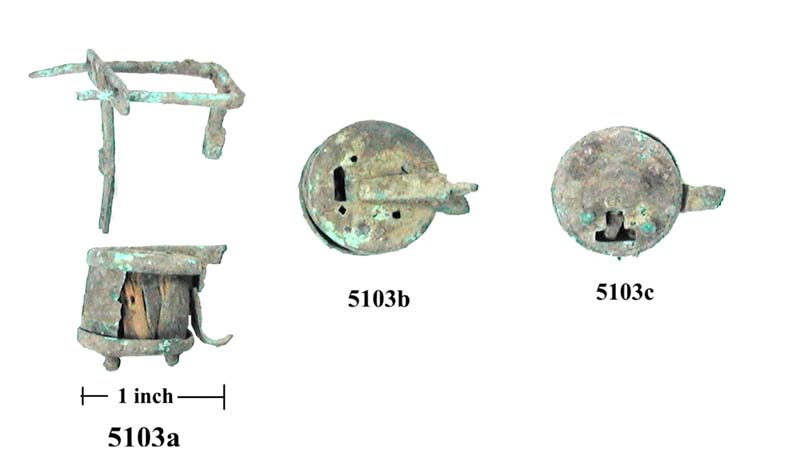
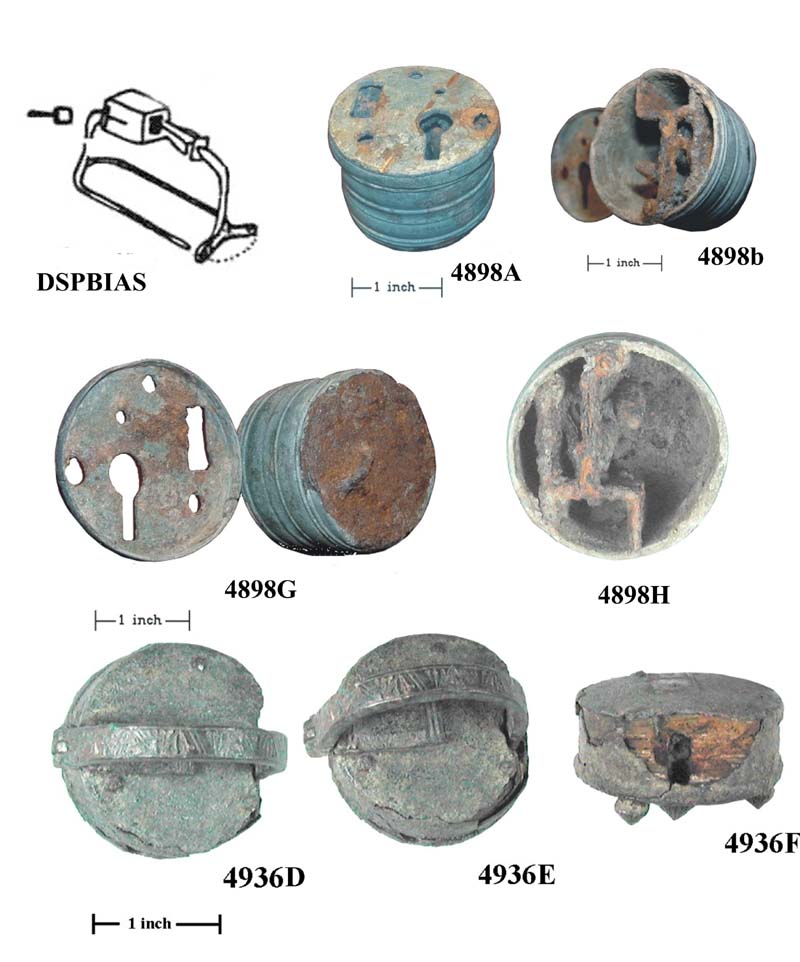
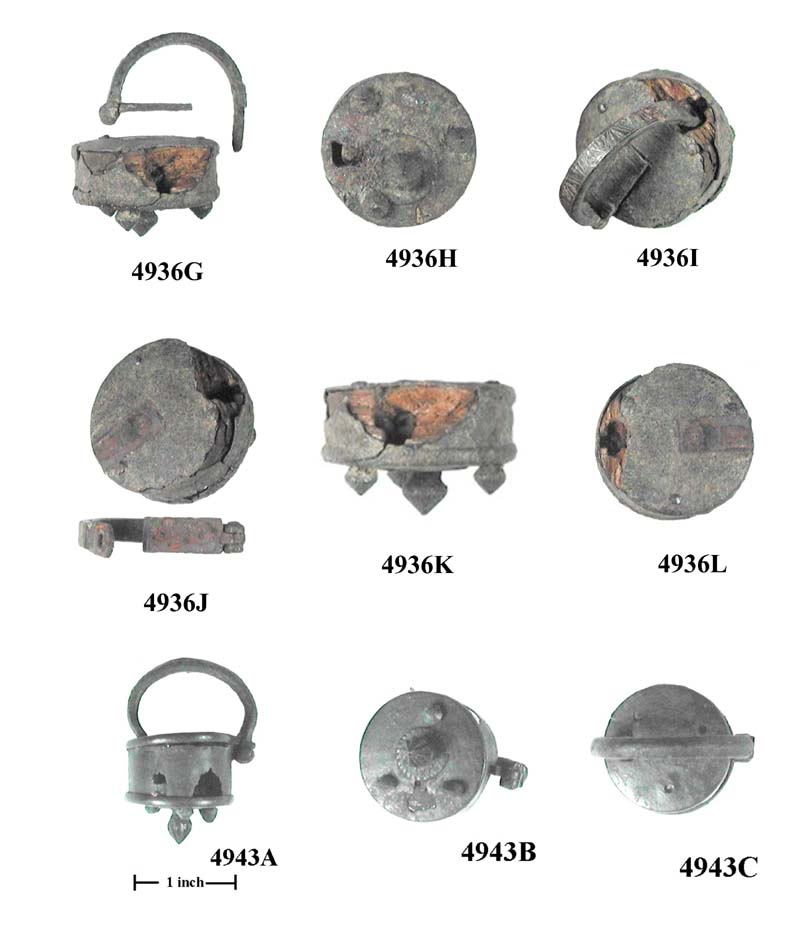
Lever padlocks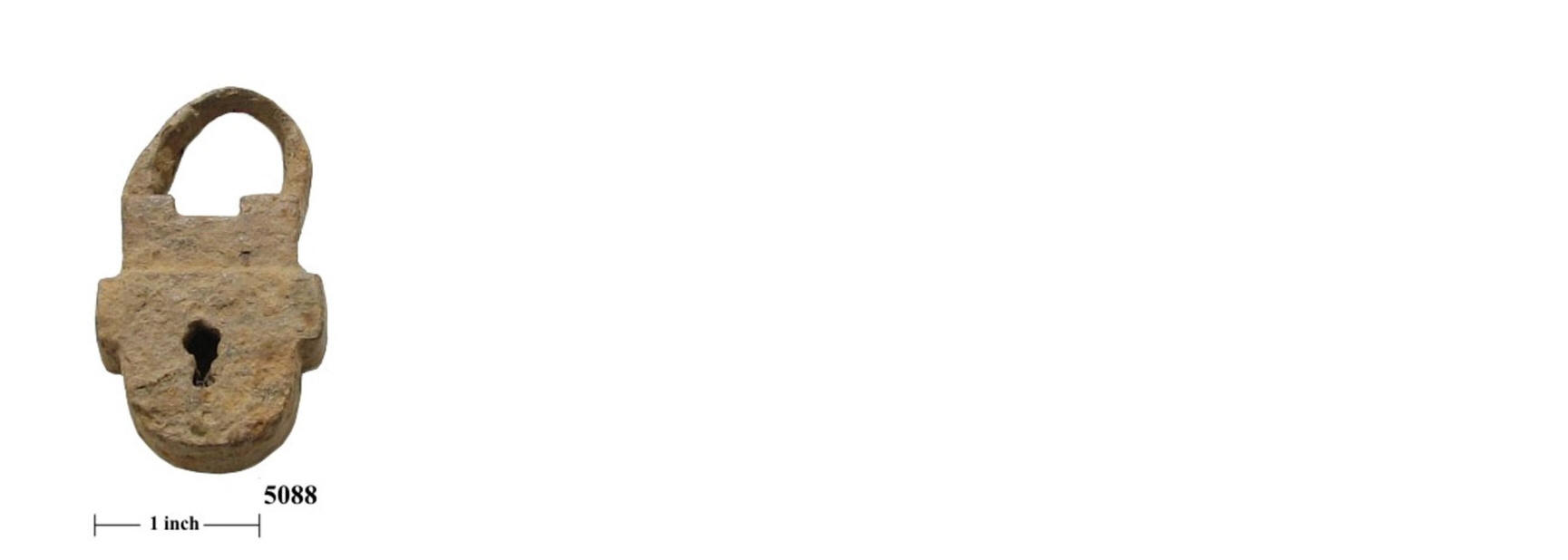
5088 I'll offer this one (above) as a possibility. It was
represented as a Roman padlock, but I'm not so 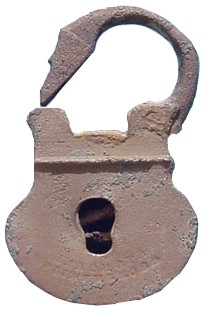 sure.
Could be late Byzantine, but as with many such locks from eastern Europe, it may
be early Slavic. The history of the development of locks in dark age and
medieval eastern Europe and western Asia has yet to be written, but is certain
to be complex and strange. It is often attempted to pass off locks similar
to the one shown here at left as Roman, even when they have inscriptions in
Cyrillic. Keep in mind that Cyrillic markings cannot pre-date the
development of that alphabet in the second half of the ninth century
C.E.
sure.
Could be late Byzantine, but as with many such locks from eastern Europe, it may
be early Slavic. The history of the development of locks in dark age and
medieval eastern Europe and western Asia has yet to be written, but is certain
to be complex and strange. It is often attempted to pass off locks similar
to the one shown here at left as Roman, even when they have inscriptions in
Cyrillic. Keep in mind that Cyrillic markings cannot pre-date the
development of that alphabet in the second half of the ninth century
C.E.
Figural Padlocks
Bronze face locks are the most treasured of Roman locks. They are both very decorative and complex. They are alleged to be late Roman or Byzantine, but their time and place of manufacture seem not to be established. Looking for evidence: I've searched for similarities to images of Roman deities without success. Some of them seem to me to be miniature theatrical masks. It also turns out that many faces exist in several versions, as though they were traditional designs, interpreted by various artisans. Meanwhile, I've discovered that there is no single place, at least no published place, where many of these figurals can be seen together and compared. Therefore, in addition to my own locks (numbered), I've collected images from various other sources (assigned names).
4339 a,e,f,h There are provisions for a shackle hinge and a face plate opening hinge. This is a trick lock, with a bronze opening lever that is pretty much corroded away. There is also a keyhole, so I don't understand everything about this lock. The interior is empty, or nearly so. I don't see anything helpful.
4815 a-e Figure of a lower class person, I think, perhaps a theatrical comic character with the straight-down hair and a vacant expression. This is about as good as they get! Shallow hole on the bottom left side which is likely a keyhole. Shape would be ok if I could close the lid. All the exterior hardware is intact. Inside, a bronze spring post remains. The face with straight hair appears again below with 4876 and in a lock shown by Declerc.
4846 b-g This is a trick lock, no keyhole. Its security depends on a potential opener not knowing the trick, that is, not knowing that such a lock might have an opening lever. Image G is a side view showing the position of the lever, and of the hinges. Unfortunately, the three tabs at the sides and bottom have been broken off. A more nearly complete example can be seen online (1st-net-lock-museum)
4856 a-h The classic Roman trick face lock. There is a narrow slot at the top/side of the head. An iron bolt is present in the closed position. All or part of the bronze mechanism is present, but the lock face only opens part way, making it difficult to examine the interior closely. There is also a sliding panel and indication of a lever at the bottom.
4876 a-d Hinged face plate and opening lever. Iron shackle missing, but iron bolt in place, locked position.
4901 a-c Front face plate only. Strange features, with exaggerated nose and horizontal embossed lines perhaps representing a beard.
5067 a-d Front face only. The casting is much deeper than usual, since it must have contained the mechanism and keyhole for a relatively large key. The keyhole is curious, and the forked configuration implies that the mechanism was rotary, and so designed that the key would be turned either to open or lock, then withdrawn. The bolt, then, was not spring loaded. 5067B shows the small cast-in hole opposite the keyhole where the key post would have been mounted, but it is now missing. Also no stains from any iron components. I believe this to be Minerva, goddess of wisdom and the crafts. Image 5067a also appears on the cover of The Antique Lock Collector for the issue of April-June 2006.
Menl This specimen from a British collection (finds.org.uk) is so similar to 5067 that I had to look at it carefully at first to be sure they weren't identical! No sign of a keyhole on the side, though, the face is rounder, and there other subtle differences in the modeling. Looks like it might have come from the same workshop, maybe by the same artisan.
Kenner I include here an excellent line drawing showing the operation of a trick face lock, with sliding panel (a) and release lever (b) (Festschrift, Bayerische Handelsbank)
Sidros-1 thru 3 Another British find of a bronze padlock cover with the female face mentioned above, from the UK Detector Finds Database (ukdfd)
5093 This is a complete trick lock with the same image as 4901. The nose is a bit shorter, that's all. The layout of the cover plate is the same. I note that the bolt is a small diameter iron pin, here either retracted or rusted away. The iron opening lever is quite prominent at the bottom. The shackle still turns on its pin and opens part way. I believe this bearded face represents the god Silenus. A similar lock can be seen in the Pankofer collection.
5098 Face lock cover, unfortunately badly damaged in antiquity. However, it is clearly the same general design as 4856, tiara and all. After discovering three pairs with a common design, I'm beginning to wonder how many unique images were actually used.
5111 Have not yet identified this round faced lady with heavy hair. The features are not as sharp as most, due to the artisan's work, not corrosion. This is also a cover, not the complete lock. The top hinge missing, but bottom latch intact.
5116 Complete lock, showing a male face wearing the close fitting felt skull cap, or pileus, of an artisan with a band at the edge. Worn at a rakish angle. This is a trick lock with the cover release lever at the lower right side. When open, that release lever can be seen still covering part of the hole for the cover latch pin. The keyhole shows that it took a drilled key; the iron keyhole post is still in place, though quite rusty.
5121 Here's still another version of the comic character with the straight hair and exaggerated nose. This one is the lock cover only, and the features are a bit blurred by corrosion.
Zara-30 This is an example from the British Museum, as shown by Zara. The face appears to me to be similar to 4815, 4876 and 5121, with the hair hanging straight down.
Kenner-2a through 2f These are six images of a face that I have not seen elsewhere. I don't know who is intended to be portrayed here. (Festschrift, Bayerische Handelsbank)
Patxi-1 This one was found on a Spanish forum (miarroba), and I know nothing about it. It does resemble other straight-hair images above. It's also of special interest in having a key, the first I've seen associated with this type of lock.
Schm-1 A very distinctive figure that shows up occasionally is this grotesque mask from the Schmoeckel collection. Perhaps it would be a satyr? Or a demon?
Face figural padlocks

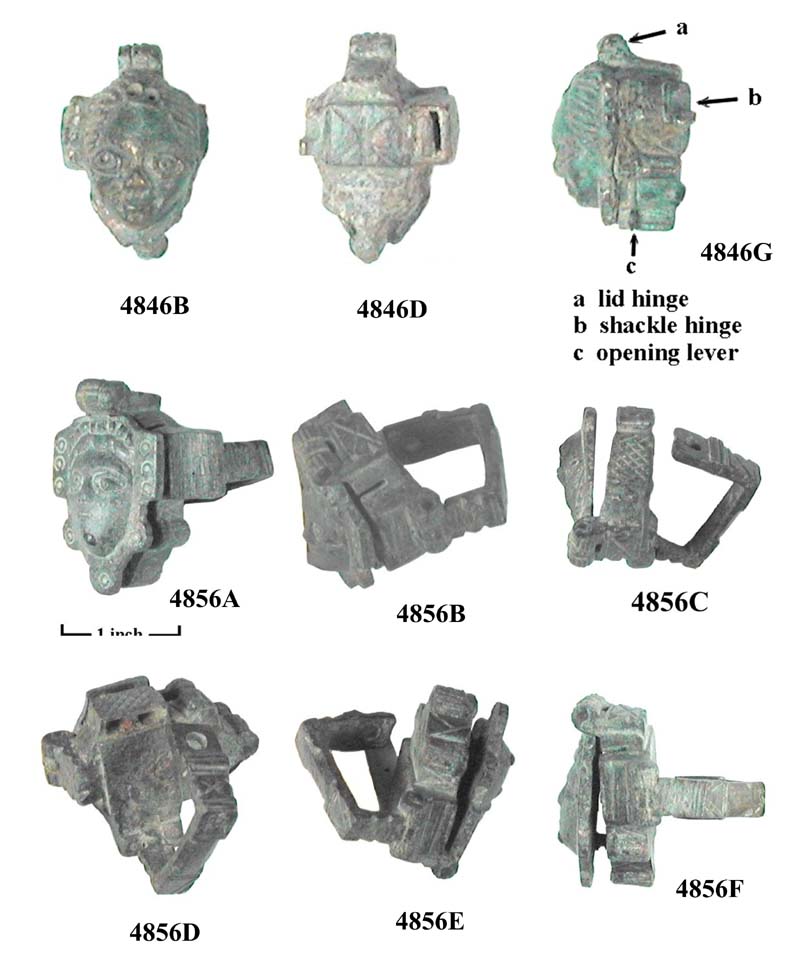
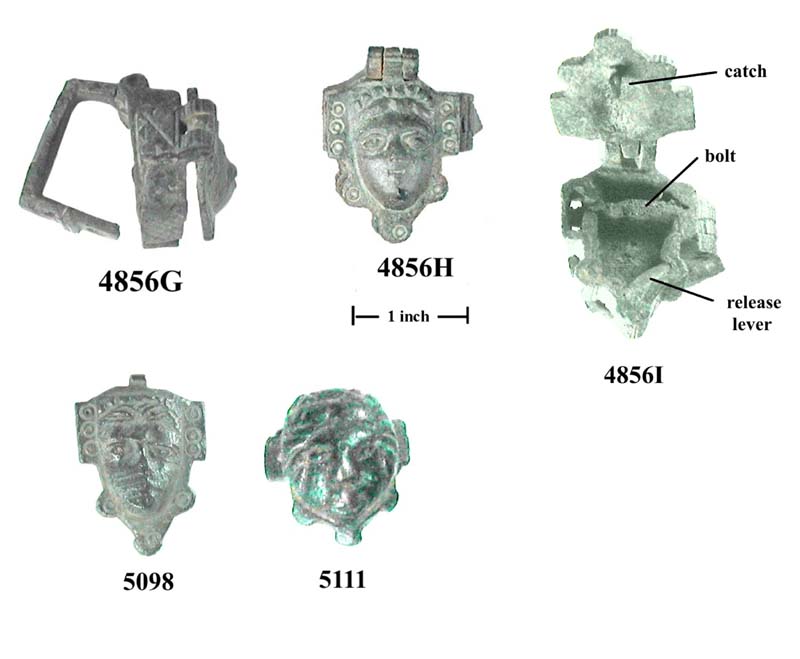
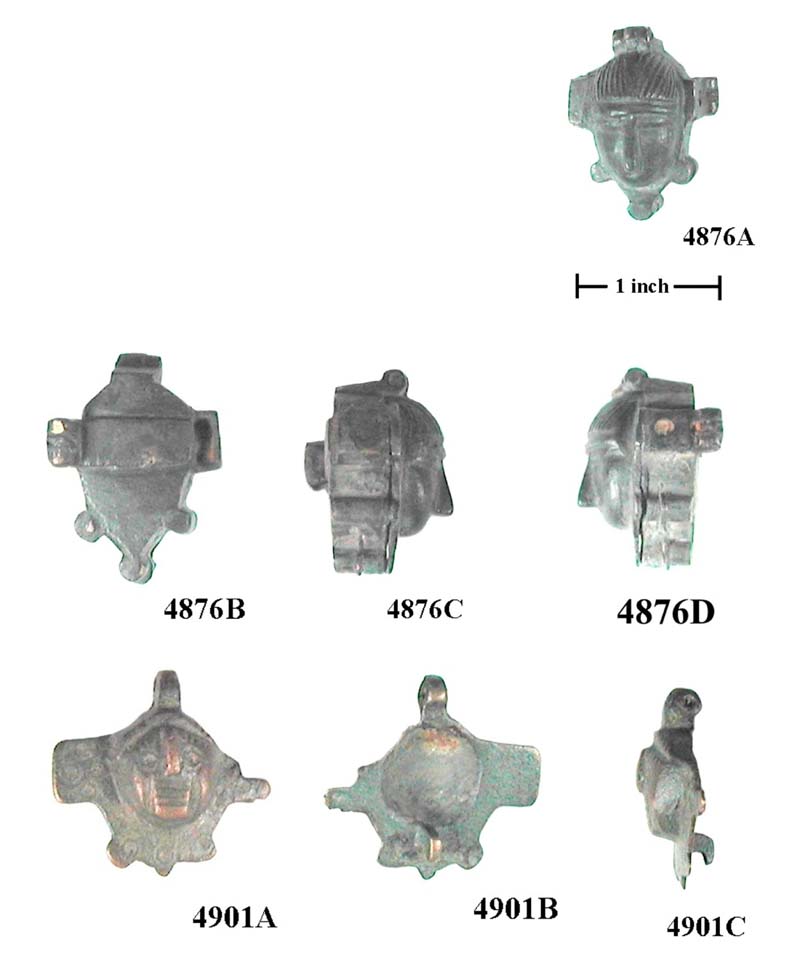
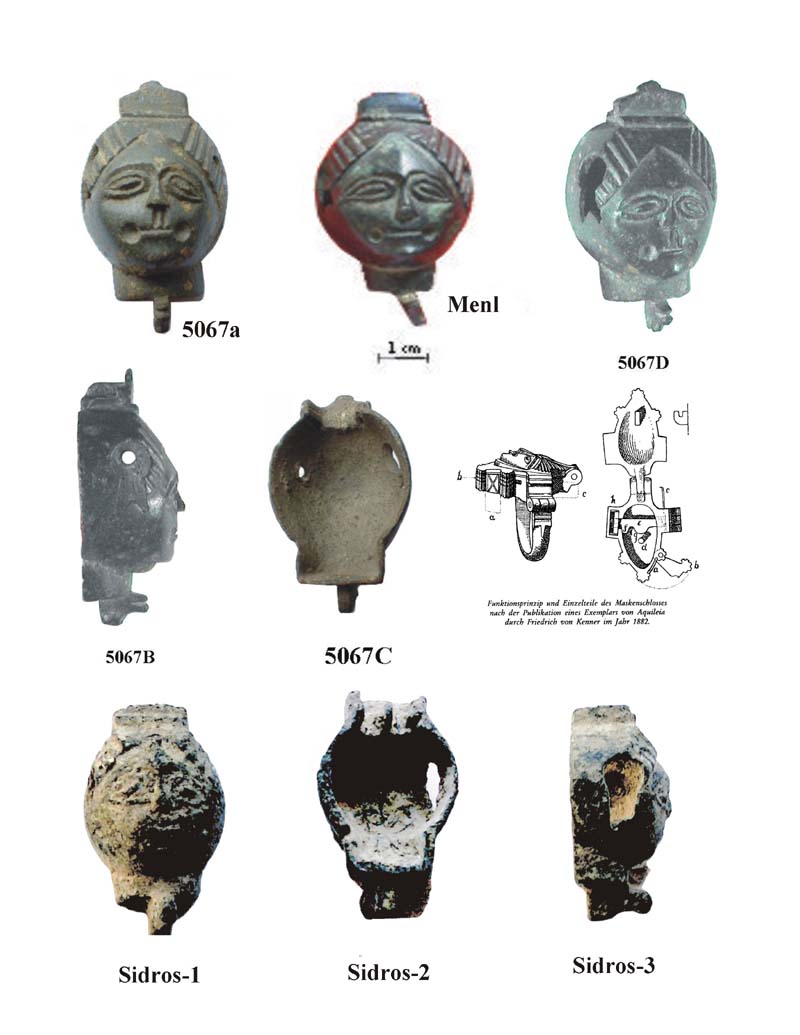
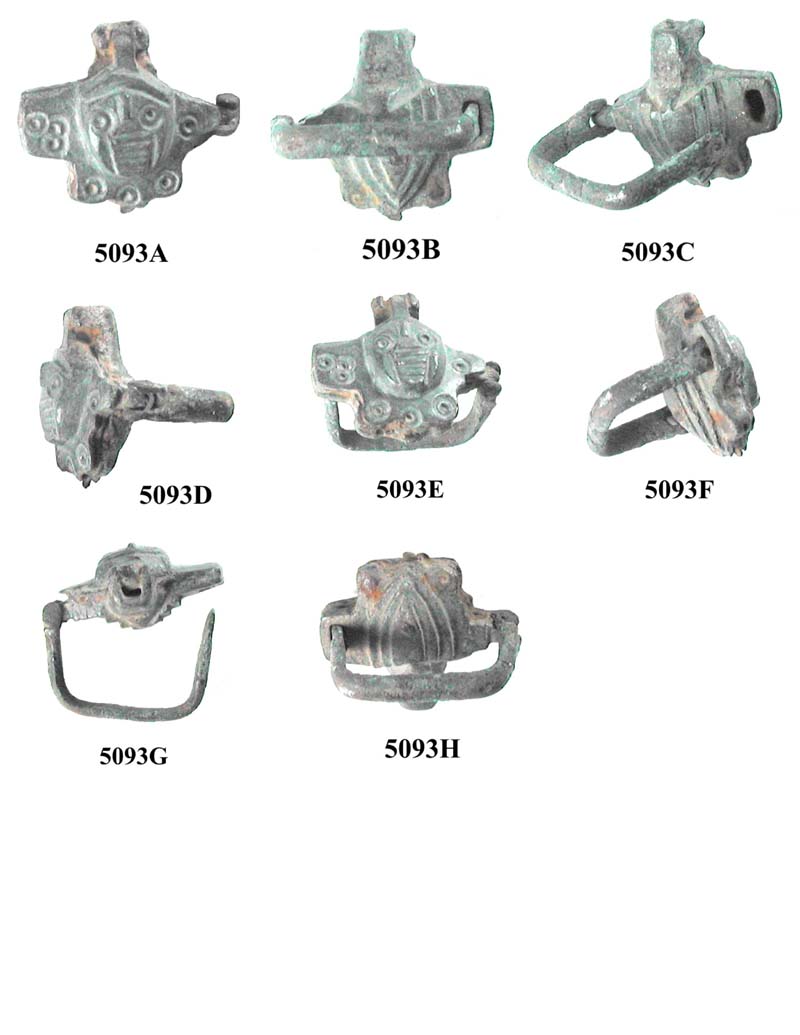
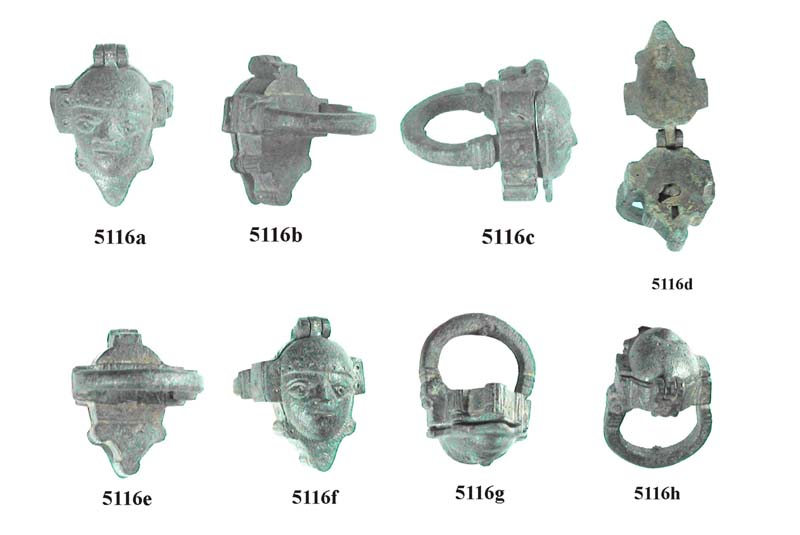
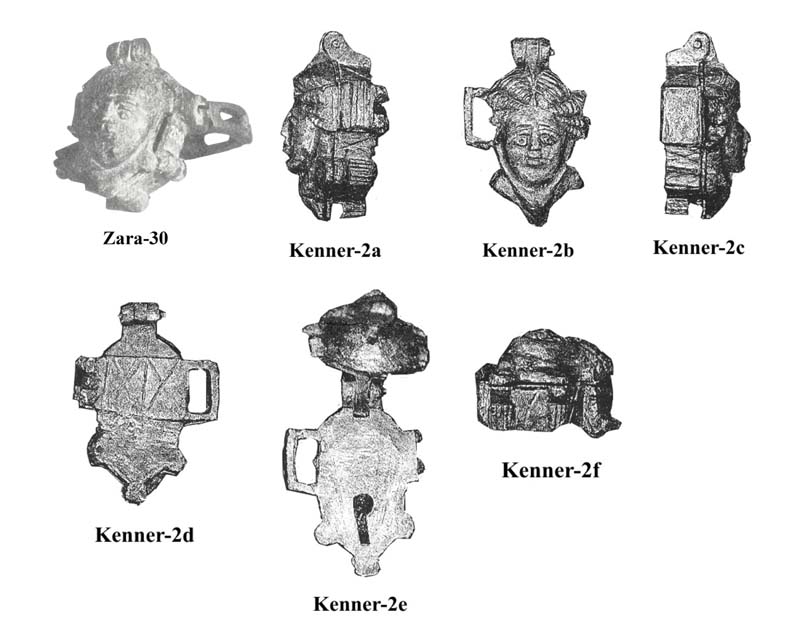
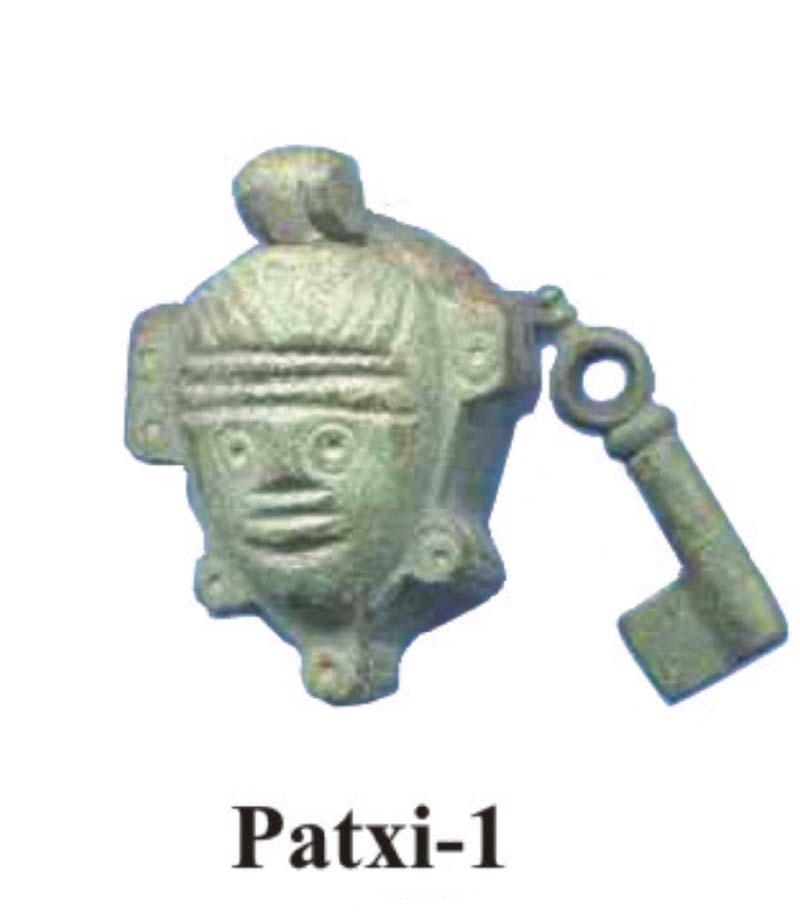
I'm still looking for information on the dates of these little Byzantine barbed spring padlocks. All examples that I have been able to obtain are half locks. The halves would have had to be joined by soldering, but no trace of that remains. Shackle/spring assemblies are missing. Still, these are delightful remnants, and I'm hoping to learn more about them. One problem in dating and assigning is that other states/cultures in the region produced such locks. For example in Volga Bulgaria in the 9th-10th centuries, "The characteristic elements of Bulgaria were . . . . bronze locks in the form of animals, . . ." (kcn.ru/history) And another reference (russian brideguide) mentions a lock from the same period in the form of a butterfly, found in a barrow. The Persians made animal figurals (Tanavoli), and are known to have made locks as early as the 5th century.
5036 a,b This was billed as a "Byzantine padlock, in the style of English medieval barrel locks" I suppose that would be because of the characteristic stubby legs and pack saddle. De Clerc (Open of Dicht) shows a similar Byzantine horse with saddle)
5053 a,b Not sure what kind of animal this is, but seems to be wearing some sort of harness. And what of the marking on the rear end? A brand?
5063a,b This sold as a Roman "furniture applique" but is obviously half of a dog lock, with barbed spring mechanism.
5078a,b Half of an animal figural, from the Balkans. The long, slender neck is familiar, as is the circle-dot decoration. The prominent, erect ears suggest a donkey or mule.
5079a,b Still another animal figural, this time from a fowl, perhaps a duck. The usual circle-dot decoration.
5082a,b,c This traditional dolphin is alleged to be a fragment of a lock
Animal figural padlocks
